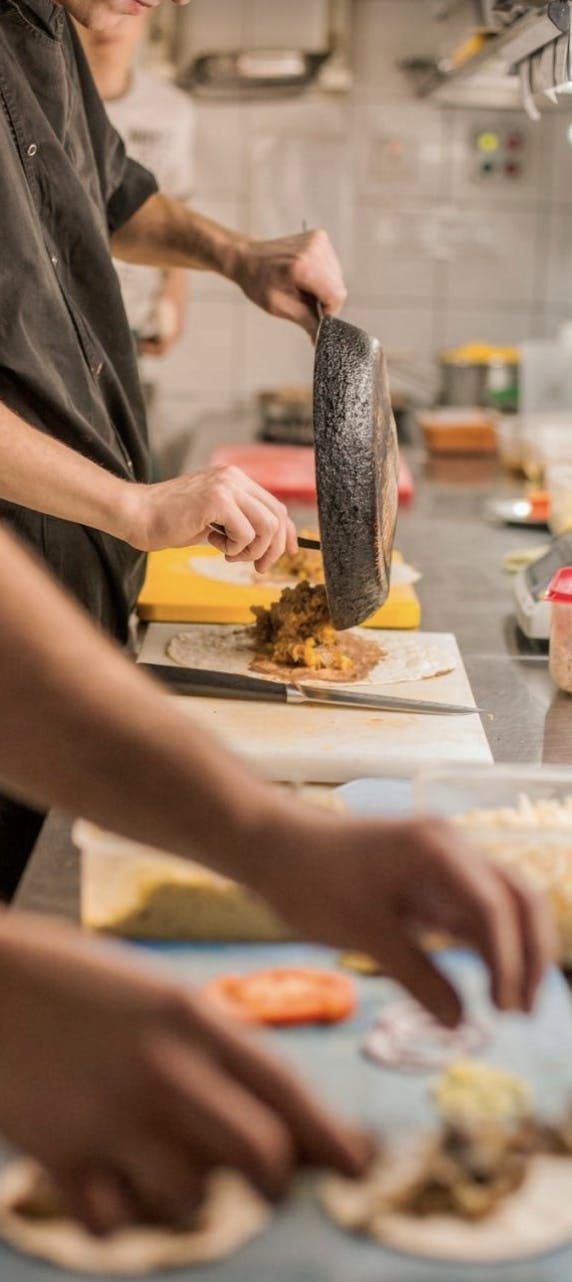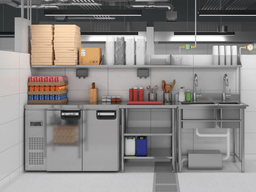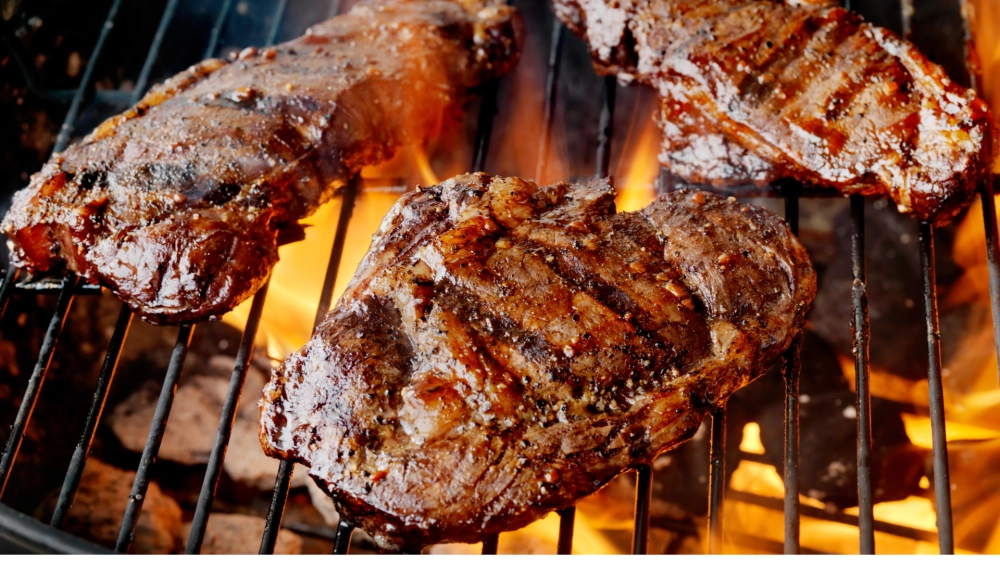Five types of Ghost Kitchens you didn’t know about
Table of Contents
CloudKitchens
How many tacos can be delivered from a 1000sqft restaurant?
The same amount as a 200sqft ghost kitchen.

Five different types of ghost kitchens you probably didn’t know about – and which one’s right for you.
We’re serving up the inside scoop
With COVID-19 reshaping the restaurant industry, restaurateurs are turning to ghost kitchens, which come with low startup costs and unlimited growth opportunities. Ghost kitchens help restaurant owners leverage the spike in online delivery demand, providing them with the secret formula for restaurant expansion.
The rise in popularity of food delivery apps like GrubHub and DoorDash has contributed to more customers skipping the dine-in experience and ordering straight from the comfort of their own homes.
And this trend isn’t going anywhere. In fact, online delivery has grown 300% faster than traditional dine-in.1
Consumers are ordering online delivery more frequently each week and in turn, restaurant owners are turning to ghost kitchens to meet this shift in demand.
Even if a traditional brick-and-mortar restaurant has to close, restaurateurs are quickly shifting and opening back up in ghost kitchens, which are fast, easy, and inexpensive to set up. This culinary concept brings new opportunities for restaurant owners to build a thriving business, even in the midst of a pandemic.
With much lower overhead costs, opening a restaurant becomes much less risky of an endeavor. It’s a great way to test your concept in the market without spending time and money on a full buildout and crossing your fingers hoping it’ll work.
This alternative may be the perfect solution you’ve been searching for, but let’s take a step back and look at what ghost kitchens really are and what they mean for you and the future of your restaurant business.
What is a ghost kitchen?
A ghost kitchen is a commercial kitchen built for delivery. Each kitchen is designed to fulfill delivery orders faster and with better accuracy. You’ll have the commercial kitchen equipment you need to get started, so you can customize the rest.
Think of it as a restaurant kitchen operating as a digital storefront, with a few back-of-house staff members working on fulfilling online orders. Instead of a physical location, your presence is digital, allowing you to reach more customers than you ever could with just a physical location.
Ghost kitchens, also known as virtual kitchens, allow restaurateurs to expand their reach through each food delivery app. They’re strategically located where the most online food orders are taking place. And since they’re not focused on high foot traffic, that means the real estate is less expensive, too.
Instead of a full front-of-house staff, you only need a few back-of-house staff members to get cooking.
Ghost kitchens simplify delivery and maximize your return on investment, thanks to low upfront costs compared to traditional brick-and-mortar.
We’re here to provide you with everything there is to know about ghost kitchens and how they compare to traditional brick-and-mortar so you can choose the best option that’s right for you.
What’s the difference between a ghost kitchen and delivery at a brick-and-mortar?
| Factors | Ghost Kitchen | Delivery at restaurant |
|---|---|---|
| Overhead costs | Low | High |
| Delivery Flow | Set up optimized for seamless delivery | Crowding up and compromising the walk-in/dine-in customers experience |
| Menu | Optimized (simplified) for delivery, usage of data analytics to improve offering | The same menu but changed occasionally |
| Online customers | Able to target a bigger online audience within the delivery radius | Rely mainly on walk-in customers, less on online traffic |
A ghost kitchen operates differently than a brick-and-mortar. In a traditional brick-and-mortar that offers restaurant delivery services, there’s typically limited parking for delivery drivers and poor operational workflows that result in slower deliveries, more room for error, and an interrupted dine-in experience.
On top of this, you’re juggling incoming orders on multiple tablets, making it difficult to track each order and ensure order accuracy.
In contrast, ghost kitchens simplify your delivery operations and increase your efficiency with every order. At CloudKitchens, you get the benefit of logistics and fulfillment handled for you, so all you’ve got to do is keep making amazing food. You cook up the order, place the food right outside your kitchen, and a runner will handle the rest. In other words, you fulfill more orders in less time.
You may already be delivering out of your brick-and-mortar restaurant and are wondering how it’s any different from a ghost kitchen. We’re breaking down the key differences so you can better understand the value of each.
Less overhead costs
You’re always looking for ways to cut costs while maintaining quality, but it can be difficult in an expensive brick-and-mortar with more and more delivery orders coming in. With profit margins being squeezed from both sides and multiple delivery tablets to juggle, it is tricky to focus on delivery and streamline efficiency.
In a ghost kitchen, you’re cooking in a delivery-optimized kitchen that’s designed to cut unnecessary costs. Rent is low and efficiency is high. You have your own private commercial kitchen space within a delivery hub to cook up orders.
With lower labor costs and overhead, you’re able to shift gears and get back to the reason why you opened a restaurant in the first place: to bring tasty food to happy customers.
Optimized for delivery
Ghost kitchens provide you with kitchen space that’s dedicated to fulfilling each online order. At CloudKitchens, each one comes equipped with the proprietary software needed to track orders and decrease delivery time, meaning more happy customers leave raving reviews. All your delivery orders are streamlined onto one single tablet, regardless of which delivery app the customer is using. This means real-time, accurate data right at your fingertips.
With a dedicated onsite fulfillment team ensuring each order gets into the hands of the right delivery driver, you’re able to cook up more orders and get them into the hands of your customers in less time. The more accurate your ETA with delivery, the better online ratings you’ll receive. With your own ghost kitchen, growing your restaurant business and expanding into new neighborhoods has never been easier.
Simplified menu items
When you’re running delivery out of your brick-and-mortar restaurant, you may be more likely to include any or all menu items available for delivery. When it comes to ghost kitchens, you’re working for efficiency, and with that comes a simplified menu with items that travel well and package nicely.
With each online order, you’re able to leverage the data you receive to plan your supply chain and labor needs based on demand. This means you can optimize your online menu based on demand so you know which items to keep and which ones to 86.
This means less wasted ingredients and fewer hours spent producing menu items that aren’t in high demand. Instead, you’re able to narrow down your menu based off of what’s trending in your delivery area.
More online traffic
You know that with a traditional brick-and-mortar, location is key. But with ghost kitchens, foot traffic is taken out of the equation. You’re no longer relying on your physical storefront to bring in new customers. Instead, you’re able to reach a higher volume of customers searching for food online.
Easily set up your brand on each food delivery app with great images of some of your best dishes and that’s it. There’s no need for printing new menus or maintaining a large front-of-house staff. All you have to do is get set up online and start taking orders.
What are the different types of ghost kitchens?
| Kitchen Types | Purpose | Upfront Investment | Space | Flexibility |
|---|---|---|---|---|
| Commissary kitchens | Prep your food and distribute it to your different locations | $ | Dedicated | Low |
| Commercial kitchens | Industrial kitchen to prep food | $$$ | Dedicated | Low |
| Incubator kitchens | Temporary kitchens | $ | Shared | Mid-high |
| Kitchen pods | Kitchens that can be transported between locations | $$ | Shared | High |
| Ghost Kitchen (Delivery Kitchen) | Kitchens designed & built for food delivery | $$ | Dedicated food prep, but shared storage and processing center | Mid-high |
Ghost kitchens come in all shapes and sizes, with some spaces being shared and others being used by just one restaurant brand. We’ve broken down the different types so you can understand which is the best fit for you.
1. Commissary kitchens
Let’s say you’re a food truck owner with multiple food trucks in the LA area. With limited food prep and storage space, it can be difficult to fulfill each order quickly. With commissary kitchens, you have dedicated space to prep your food and distribute it to your different locations.
You get a shared kitchen space that’s available to rent based on your schedule, which makes it super flexible. Whenever you need more space to prepare orders or store ingredients, you can access your commissary kitchen without having to incur the costs of actually owning the facility.
You’ll have the basic equipment you need to get started quickly and efficiently. A commissary kitchen provides a lower-cost alternative to opening up a new kitchen on your own. You’ll be able to rent the real estate without the financial setback or commitment.
2. Commercial kitchens
Do you typically receive larger online orders where you need plenty of kitchen space and support to fulfill them? Commercial kitchens are larger, industrial kitchens that are licensed to restaurant brands and catering companies to prepare food.
With a commercial kitchen, you’re set up with your own private kitchen space to cook.
There’s no need to rent out specific time slots or worry about sharing your space. With commercial kitchens, you have your own dedicated space to prep orders whenever you need it.
3. Incubator kitchens
Incubator kitchens, also known as pop-up kitchens, are temporary kitchens that are attached to a brick-and-mortar restaurant, within a food truck, or even a kiosk. These pop-up kitchens are designated as space for preparing incoming delivery orders.
This helps staff divide and conquer, allowing the workload for deliveries to shift to the incubator kitchen instead of tackling all orders in one kitchen which can lead to inefficiencies and incorrect deliveries.
These kitchens are designed to help streamline efficiency for each delivery order that comes into the brick-and-mortar restaurant. It provides a dedicated space for order prep and a designated area to hand off to arriving delivery drivers.
Within each incubator kitchen, you have shared space for delivery only so you can try new brands at a time that works best for you. Similar to commissary kitchens, you have the flexibility you need to test multiple concepts out of one single kitchen space.
4. Kitchen pods
Compared to other types of ghost kitchens, kitchen pods are easy to transport between locations such as parking lots and behind restaurants. These usually come in the form of shipping containers used as flexible kitchen space. This provides restaurateurs with the ability to cook anywhere and reach customers on the ground.
Although they’re easier to transport, they’re also much smaller. Plus, kitchen pods are usually dark without any windows, making it more difficult to quickly prepare orders and effectively meet delivery demand. It can be difficult to efficiently prepare large orders with minimal ventilation and natural light.
5. Ghost Kitchen by CloudKitchens
CloudKitchens provides restaurateurs with their secret sauce for delivery expansion. Whether you’re a food truck owner, franchisee, local restaurant owner, or part of a national chain, we’ve got the expertise you need to get your delivery down to a science. CloudKitchens offers a variety of delivery solutions to best fit your specific needs. If you’re looking to grow your restaurant business or simply need some extra prep space we’ll be with you every step of the way.
You’ll have the support you need to fulfill each order and meet each delivery ETA, with the help of our onsite fulfillment team. In fact, you don’t even need to leave the kitchen to hand off each order. We have dedicated team members who will bring each order you complete to the correct delivery driver and ensure they’re on their way in no time.
Plus, we’ll take care of the cleaning, maintenance, and security – so all you’ve got to do is cook.
Incoming orders are streamlined on one single tablet, so you’re tracking each order with more accuracy, all in one place.
Every kitchen comes with a three-compartment sink and commercial hood, vents, windows, and air conditioning. You’ll be set up with all the essentials so you can customize the rest to fit your needs.
You’re able to see your ROI in months instead of years, and the possibilities for growth and expansion are endless.
Ready to see a ghost kitchen in action? Tour a CloudKitchens facility today!
Whether you’re looking for a ghost kitchen in Austin, NYC, Philadelphia or more, we’ve got you covered. Contact us today to find the location nearest you!
Read More:
- Sales vs Business Development: Which One to Pursue for Ghost Kitchens?
- How Much Does It Cost to Start a Ghost Kitchen: A Complete Guide
- Ghost Kitchen vs. Virtual Kitchen: What’s the Difference?
- Ghost Kitchen Profit Margins: What You Need to Know
Explore ghost kitchen locations across the US:
- Ghost kitchens in San Francisco
- Ghost kitchens in LA
- Ghost kitchens in NYC
- Ghost Kitchens in Toronto
- Ghost Kitchens in Atlanta
- Ghost Kitchens in Dallas
- Ghost Kitchens in Chicago
- Ghost Kitchens in Denver
- Ghost Kitchens in Miami
| DISCLAIMER: This information is provided for general informational purposes only and the content does not constitute an endorsement. CloudKitchens does not warrant the accuracy or completeness of any information, text, images/graphics, links, or other content contained within the blog content. We recommend that you consult with financial, legal, and business professionals for advice specific to your situation. |
Sources:
https://upserve.com/restaurant-insider/online-ordering-statistics/
More insights & stories
There’s more where that came from.
Get in the know and check out our additional insights




